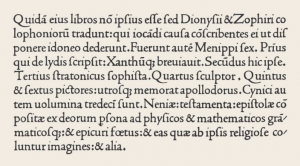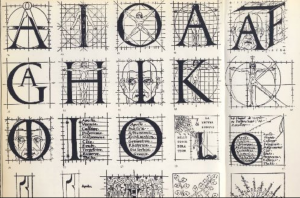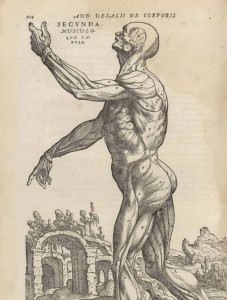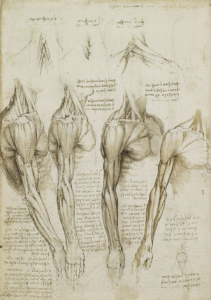Lecture: Block books and Baroque (1450 – 1750)
In this week’s Survey, we travelled back to the time of scientific revolution. Covering the artistic movements from the Renaissance, Baroque to Rococo in 1450 – 1750, it was the period of discoveries and Humanism (belief based on scientific findings and knowledge) that marked the dawn of modern technology.

1470 – Typography designed by Nicolas Jenson from Judy’s lecture

1529 – Champ Fleury (Flowery Field), Geoffrey Tory from Judy’s lecture
Followed up by the printing press invention by Bi Sheng and Gutenberg, more typefaces and typographic styles began to emerge in this time. As someone who is very passionate about typography and design, the origins of these various typefaces really strike my interest. It is fascinating to see how much attentions makers and designers paid to the subtle change in line weight, embellishment (ex. foot) and kerning of letters. It’s so impactful that some of these typefaces, like Jenson, Baskerville, Caslon, Garamond and Granjon, after a span of 300 – 500 years, it still makes appearances in the Adobe Typekit and other digital softwares.
Research: Anatomic Study in late Renaissance
As we mentioned in the previous section, the Renaissance was the Golden Age of profound discoveries and inventions. It was beginning of new philosophical stance known as Humanism that led to the immense progress in many fields of study including science, art and mathematics etc. No doubt the collective knowledge discovered by Renaissance scientists also made a huge contribution to medical technology and art styles from the Renaissance to this day. For this week’s research, we will be focusing on the fascinating discoveries of our human bodies!
Origin of Human Anatomy
The discovery in modern human anatomy studies can be traced back to the “Father of anatomy” of Andreas Vesalius (1514 – 1564). Being a professor of anatomy and physician, Vesalius, was supplied with criminal bodies and materials for dissection. This immensely helped him in his anatomic study and led to the revolutionary discoveries on human body system in the Renaissance. After numerous observation and studying, he also came to the realization that some of theories and teaching of human anatomy by Galen (also known as Aelius Galenus) was false. For instance, Galen stated that men have less ribs than women, while on the other Vesalius disproved this teaching and later demonstrated that men and women have equal among of ribs in their bodies. In Versalius’ book collection (illustrated by Titian’s pupil Jan Stephen van Calcar) , “On the fabric of the human body in seven books”, he made 200 unquestioned theories on anatomy and recorded the formation of muscles, blood vessels, skeletons, nervous system and viscera in the body system. Vesalius’ findings and discoveries were remarkable to the collective knowledge in science and biology.

Andreas Vesalius’ anatomic book collection, illustrated by Calcar

Muscle drawings by Leonardo da Vinci
Science & Art
Many Renaissance artists had taken a new interest in anatomic studies to revive the liveness in human figure drawings. One of the most influential artists in anatomic studies was none other than Italian artist Leonardo da Vinci (1452–1519). Da Vinci invested his time on figure study by performing anatomical dissections at the hospital of Santa Maria Nuova. Through his examination, he made important discoveries in areas like the heart’s four cavities, the cerebral ventricles, cranium’s frontal sinus and the nature of muscles. In his study of figure drawings with nude models, he also analyzed the human body in relation to force equilibrium (composed by static, dynamic and kinematic forces).
His collection of anatomy illustrations was arguably the most sophisticated representation of all time as the anatomic illustrations were detailed, accurate and important for late scientific studies. Many famous Renaissance artists continued to follow his lead in creating depth and liveliness in figure paintings as well. Motivated by his curiosity in science and art, no doubt Vinci’s discovery enriched the visual vocabulary in the late Renaissance. However, unlike Vesalius, his notes in scientific discoveries were never published and it made minimal impact to the medical field in Renaissance.
Reference:
“Vesalius’s Renaissance anatomy lessons.” The British Library Board

Recent Comments